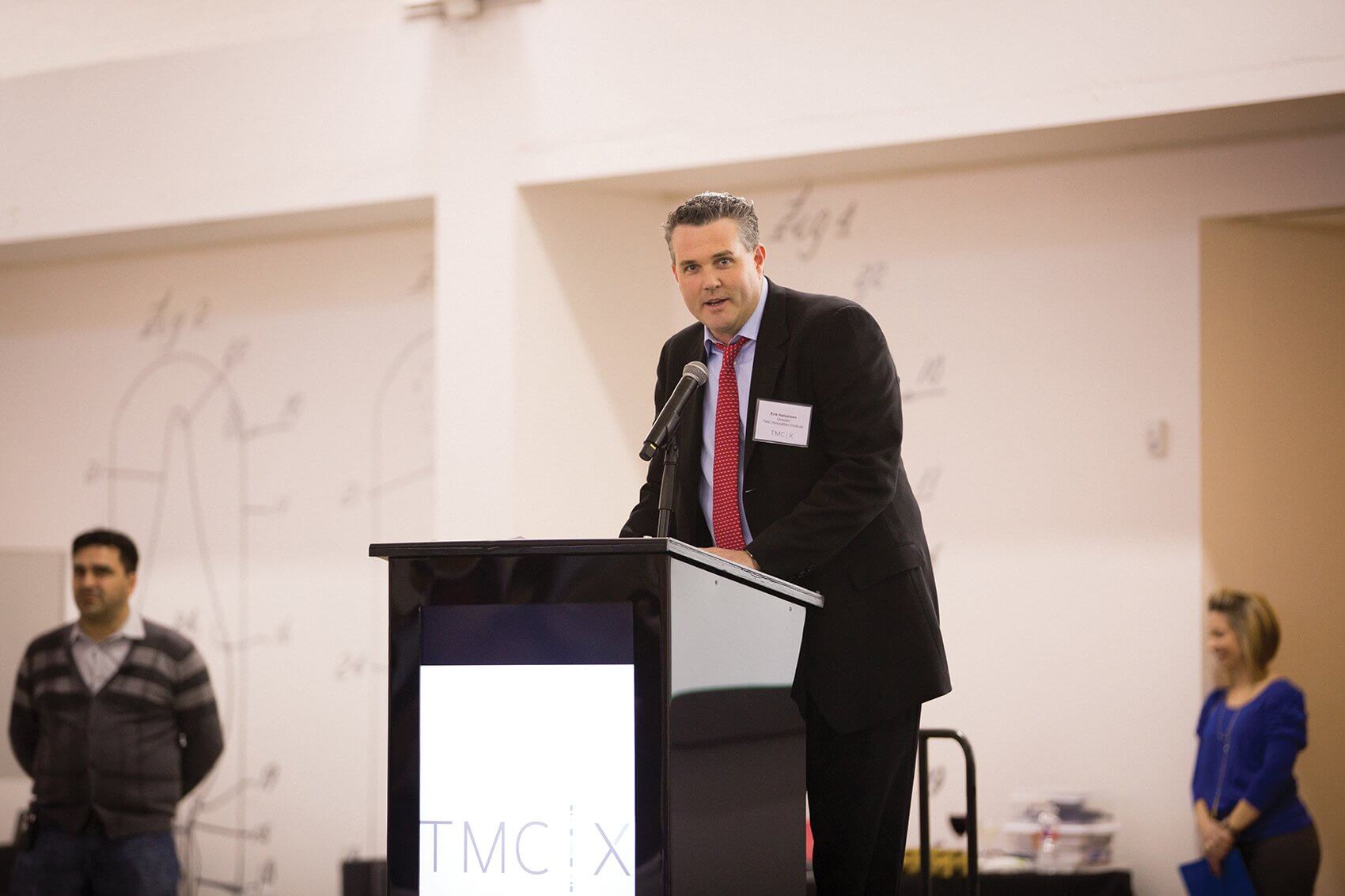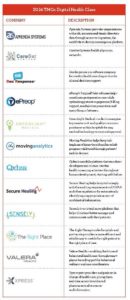TMCx Goes Digital

Earlier this year, a steady stream of medical entrepreneurs from near and far walked through the tiered, luminescent hallway—known informally as the “innovation portal”—into their new workspace. As they unpacked luggage, juggled parking passes and ID badges, scribbled notes on personalized whiteboards at their workstations and darted back and forth between orientation sessions, these eager entrepreneurs got a taste of the controlled chaos that would define the next five months.
Twelve companies specializing in digital health were welcomed as the second class of TMCx—the Texas Medical Center’s accelerator program that acts as a gateway to the facilities, resources and network of the world’s largest medical center.
“Essentially, we’re here to leverage our network and the organizations that are part of the Texas Medical Center, for the benefit of these entrepreneurs,” said Erik M. Halvorsen, Ph.D., the new director of the TMC Innovation Institute. “These companies have access to the largest collection of top physicians, scientists and business expertise that exists on a single campus—one which serves over 7.2 million patients each year. If you combine that with the sheer volume of data that flows through our network—as well as the breadth and diversity of these different organizations—it can be a huge asset for digital health innovation.”
The second year of the TMCx program marks a notable change: each class will focus on a specialized subset of health care innovation, with two classes participating each year.
From January through June 2016, the 12 companies will focus on digital health. From August through December 2016, a third class of companies—yet to be selected—will focus on medical devices.
“By all measures, the first class was an incredible success,” said Halvorsen, referring to last year’s inaugural cohort of 21 companies that solidified the accelerator’s status as a beacon for life science entrepreneurship. “But at the same time, there was also some learning that took place along the way. One of those observations was that by focusing the class around particular areas, we could create more synergy for the companies here.
“By putting the focus on digital health, we’re hoping to enable fortuitous collisions between the companies that lead to collaborations and increased acceleration,” he continued. “Even in the first four days, the companies are already actively collaborating and looking for ways to help each other. It’s really exciting to watch.”
Thanks to the programmatic overhaul and a tightly woven curriculum, class two is hurtling along and showing little sign of slowing down. Between a barrage of informational sessions, detailed tours to provide an inside look at medical center institutions, and events intended to ignite conversation between the entrepreneurs, advisors and hospital stakeholders, the new arrivals barely had time to catch their breath.
“It was really great to visit the actual hospitals throughout the medical center,” said Adam Odessky, co-founder and chief executive officer of Sense.ly, a virtual nurse platform that enables clinicians to better manage and communicate with their patients. “Just understanding how their administration interfaces with treatment, how the different departments flow, and understanding how the procurement and IT processes work—it’s all invaluable. That window into the whole workflow has been instrumental in shaping how we could position our product to better serve their needs.”
Fellow TMCx classmate Katherine Chambers, co-founder and chief executive officer of The Right Place—a Houston-based company that provides tools to nursing homes and helps hospitals identify where to send patients who need nursing home care—is also looking to the future, especially as the field of digital health innovation continues to blossom.
“There’s such a tremendous opportunity within the digital health spectrum to enable workflow efficiency, so that these highly trained people aren’t stuck spending their time on administrative tasks around coordinating where a patient should go for nursing home care,” Chambers said. “That’s where technology can really serve these care teams. Solutions like The Right Place can enable physicians and nurses to spend more of their time actually assisting patients, assessing them and administrating care.”
The future of digital health is also shining brightly for Alexander Izaguirre, Ph.D., founder and chief executive officer of Aprenda Systems, which provides organizations with accurate and timely directory data through access to its Signature software.
“As a platform technology, I see us leveraging the creativity, work and efforts of all of these different companies that no other organization has,” he said. “By the end of the program, I’d love to see that up to 5,000 physicians are using Signature, aggregating great, curative data, developing profiles and sharing that information with health plans and systems. I want us to demonstrate to the world that it’s much easier to get things done when you can share your data as a currency.”
Finding the most effective ways to engage with hospital leadership and cater to potential customers was a pivotal focus of the program’s first two weeks. That emphasis culminated in a curriculum session led by Todd Dunn, director of innovation for Intermountain Healthcare, on avoiding common pitfalls and creating value for customers.
“If you’re an entrepreneur, always remember that in an early stage company, you have assumptions that you need to test and get evidence
for,” he said. “Whether you validate or invalidate your assumptions, it doesn’t matter—you need to do both. It’s crucial to spend time from an empathetic mindset and be mindful of your customer, what they struggle with and what they hope to do. Make sure you really understand them before you diagnose what you believe their problems are.”
Last year’s lessons informed more than just the current structure and focus. Weaving connective threads between TMCx alumni and current cohort members, Niko Skievaski, co-founder of Redox and a participant in last year’s class, provided some insight into how to best leverage the resources available and dispensed a healthy dose of perspective.
“By investing in innovation, bringing in the best companies from across the country and putting them on stage in front of all these health systems, the Texas Medical Center is making Houston a national hub for innovation,” said Skievaski. “A lot of accelerator programs will own a piece of your company, and the point of them will be to launch you out at the other side at a $20 million valuation, so that the equity they bought three months earlier can now be valued higher. Whereas, the motive here is to simply help you. That’s how I looked at the program when I was here.”
The responses from the companies have so far been overwhelmingly positive. Based on feedback collected from the first several weeks of the program, 126 out of 150 responses demonstrated that a session either “exceeded expectations” or “far exceeded expectations.” If that’s any indication, the next four and a half months are likely to contain even more pleasant surprises.
“In my experience, the TMCx accelerator is the most closely relevant to what we’re doing as a company,” Odessky said. “Other business accelerators have either been too high-level, helping companies run their businesses from a financial or corporate governance perspective, while others have been focused on a technology leadership perspective. But this program, specifically, is centered around helping health care entrepreneurs build their businesses.
“That’s tremendously helpful, and is allowing us to shape our business around some of our biggest customers—which could be, in fact, places like Texas Children’s and MD Anderson,” he added. “That’s crucial because it helps us align what we do, how we work and our overall value to be much closer to the people we serve.”
(Click to enlarge and read more about the new TMCx companies)








